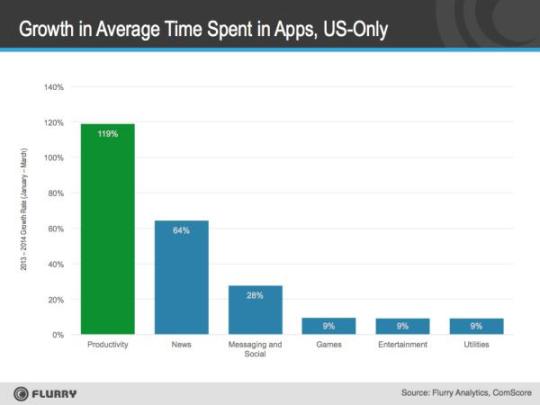While established mobile platforms like Facebook and Google are already thinking about the post-mobile world, with bets on fire alarms, robots and virtual reality, the whole world is still adjusting to the post-PC world, where mobile rules. The dominant PC platform, Microsoft is still playing catch-up on mobile and its newly appointed CEO is expected to announce the long rumored Office suite for the iPad tomorrow.
Mobile devices have quickly proliferated and their shipments have eclipsed those of PCs, but they haven’t made a big dent in the productivity market to date. Time-spent on these devices is still concentrated in games, social networking, messaging and entertainment. But, it appears that this about to change and Microsoft’s announcement of Office for iPad couldn’t be more timely. In fact, it can define Microsoft and its newly appointed CEO’s tenure in the post-PC world. In a new analysis we conducted between the months of January and March 2014 we found that the average US consumer spends 119% more time in productivity apps than they did over the same period a year ago. This includes time spent in apps on iOS and Android devices, both tablets and phones. This growth rate eclipsed all other categories including Messaging, Games and News.

The actual numbers are still relatively low as the average US consumer spent 5½ minutes per day in productivity apps. This compares to 2½ minutes per day in March of 2013. This takes into consideration the relatively low penetration of productivity apps in general. In fact, an analysis of 7,800 productivity apps on the Flurry platform shows a total reach of 32 million US mobile users. But the year-over-year growth rate is still significant and indicates a shift in consumer behavior. Applications such as Evernote and Dropbox are gaining traction and new emerging apps such as Quip, Slack and Acompli are ushering a new era of mobile-first productivity applications. Continued innovation and growth in this category will accelerate the adoption of productivity apps on tablets and phones, and spell further doom for the PC industry.
Analysts are still divided on whether Office for iPad will fuel this industry and make Microsoft relevant in the post-PC world, or will simply be a product from another era, brought to mobile without much impact. The rumor of the announcement gave Microsoft a nice 4% boost in market cap, but the world is watching what Microsoft’s new CEO will say more than what the product will do. One thing we know is right: timing. Productivity apps are gaining tremendous traction on mobile devices and Microsoft’s products can simply be the second-stage booster for this industry. It will be fun (and productive) to see what happens the next few months.